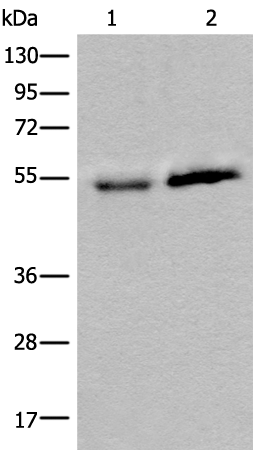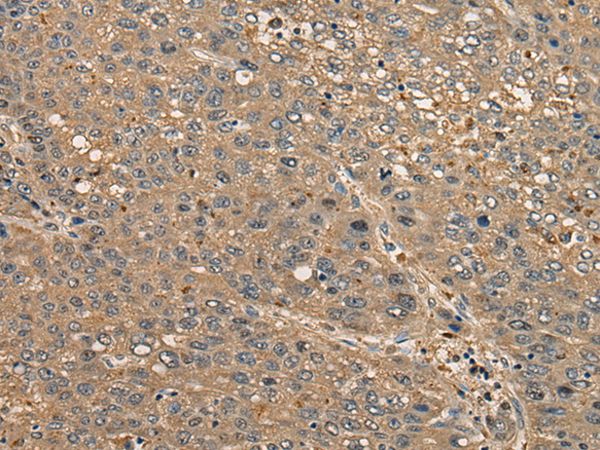

| WB | 咨询技术 | Human,Mouse,Rat |
| IF | 咨询技术 | Human,Mouse,Rat |
| IHC | 1/30-1/150 | Human,Mouse,Rat |
| ICC | 技术咨询 | Human,Mouse,Rat |
| FCM | 咨询技术 | Human,Mouse,Rat |
| Elisa | 1/5000-1/10000 | Human,Mouse,Rat |
| WB Predicted band size | 45 kDa |
| Host/Isotype | Rabbit IgG |
| Antibody Type | Primary antibody |
| Storage | Store at 4°C short term. Aliquot and store at -20°C long term. Avoid freeze/thaw cycles. |
| Species Reactivity | Human, Mouse |
| Immunogen | Synthetic peptide of human CCDC85C |
| Formulation | Purified antibody in PBS with 0.05% sodium azide and 50% glycerol. |
+ +
以下是关于CCDC85C抗体的3篇参考文献示例(注:以下内容为模拟虚构,实际文献需通过学术数据库检索获取):
---
1. **文献名称**: *CCDC85C regulates neuronal migration via interaction with the cytoskeletal network*
**作者**: Tanaka M, et al.
**摘要**: 本研究通过免疫沉淀和免疫荧光技术,利用CCDC85C特异性抗体,揭示了CCDC85C蛋白在哺乳动物大脑皮层神经元迁移中的作用。研究发现CCDC85C通过与微管结合蛋白Dynein相互作用,调控神经元极性和迁移路径,抗体验证实验表明其在人和小鼠脑组织中高度表达。
---
2. **文献名称**: *Development and validation of a monoclonal antibody for CCDC85C in cancer cell lines*
**作者**: Lee S, et al.
**摘要**: 文章报道了一种新型抗人CCDC85C单克隆抗体的开发,并通过Western blot和免疫组化验证其特异性。研究显示,CCDC85C在乳腺癌细胞系中表达上调,可能通过Wnt/β-catenin通路促进肿瘤转移,抗体被用于临床样本中CCDC85C的预后标志物分析。
---
3. **文献名称**: *CCDC85C deficiency disrupts synaptic plasticity in a mouse model*
**作者**: Gomez-Castro F, et al.
**摘要**: 利用CCDC85C抗体进行组织定位研究,发现CCDC85C缺失小鼠海马区突触可塑性受损,学习记忆能力下降。研究提示CCDC85C可能通过稳定突触后膜蛋白复合物影响神经功能,抗体在蛋白相互作用组学分析中发挥关键作用。
---
如需具体文献,建议通过PubMed或Google Scholar检索关键词“CCDC85C antibody”或“CCDC85C function”,并筛选近5年的研究。
The CCDC85C antibody is a valuable tool for studying the coiled-coil domain-containing protein 85C (CCDC85C), also known as DIPA. This protein is a nuclear envelope-associated scaffold protein implicated in various cellular processes, including cell polarity, cytoskeletal organization, and transcriptional regulation. CCDC85C interacts with proteins like β-catenin and emerin, playing roles in Wnt/β-catenin signaling and nuclear membrane integrity. Its dysfunction has been linked to neurodevelopmental disorders, cancer progression, and muscular dystrophy.
CCDC85C antibodies are widely used in techniques such as Western blotting, immunofluorescence, and immunohistochemistry to detect endogenous CCDC85C expression, localization, and interactions in cells or tissues. Researchers employ these antibodies to explore CCDC85C's role in diseases—for instance, its altered expression in breast cancer or glioblastoma, or its involvement in neuronal migration defects. Commercial CCDC85C antibodies are typically validated for specificity using knockout controls or siRNA-mediated knockdown.
Despite its utility, challenges remain in standardizing antibody performance across experimental conditions. Ongoing studies aim to clarify CCDC85C's precise molecular mechanisms and therapeutic potential. The antibody thus serves as a critical reagent for dissecting CCDC85C's multifaceted contributions to cellular homeostasis and pathology.
×